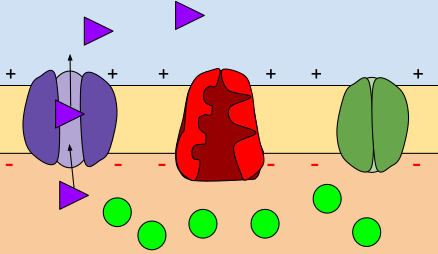Potassium delayed rectifier channel knowledge page
About
Landing page for the delayed rectifier potassium channels, of rapid (Kr), slow (Ks) and ultra-rapid (Kur) variants.
Other name for these proteins: Kv, KCNx (x denotes letter from A to H), hERG (for Kv11.1 specifically).
These channels are known to transport potassium across the plasma membrane according to the concentration gradient. In cardiac cells, they are integral to the formation and maintenance of the action potential.
Kr, Ks and Kur are proposed to be formed of proteins that are from the same families (see table below). Kv is thought to be tetrameric - made of four units of the pore-forming, alpha subunit protein. This is assembled with one or more units of the regulatory beta subunit. There may be other subunits that control channel gating.
Pictures

Fig. 1. Schematic of delayed rectifier potassium channel action (purple channel), transferring potassium ions (purple triangles) from the extracellular fluid into the cell cytosol.
Subfamilies
The following list contains a portion of all 12 subfamilies that fall under the Kv group. This portion pertains to the delayed rectifier current only.
Column Binds denotes what other protein the protein here binds to, to be functionally active. If item is blank, any binding activity was not experimentally found. Column Current denotes which delayed rectifier current the protein has been experimentally found to contribute to.
Literature
| Title | Author |
|---|---|
| Ultra-rapid delayed rectifier channels: molecular basis and therapeutic implications | Ravens and Wetter |
| A computational model of induced pluripotent stem-cell derived cardiomyocytes incorporating experimental variability from multiple data sources | Kernik et al. |
Existing models
| Title | Author |
|---|---|
| BG_Kr | S Fong |
| BG_Ks | S Fong |
| Cellular consequences of HERG mutations in the long QT syndrome: precursors to sudden cardiac death*^ | Clancy and Rudy |
| Bond graph modelling of the cardiac action potential: Implications for drift and non-unique steady states^ | Pan et al. |
| A Model of the Ventricular Cardiac Action Potential - Depolarisation, Repolarisation and Their Interaction*^ | Luo and Rudy |
Models denoted by [*] are not in bond graph form. Models denoted by [^] are part of a whole cell model.
Other annotations
| Item | Database |
|---|---|
| Voltage gated potassium channel subunits Kv1-12 | Reactome |
| Protein activity | Gene Ontology |
| Hierarchy of Kv channels | Interpro |
